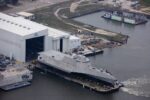India’s first indigenously built aircraft carrier, INS Vikrant (IAC-1), marks a significant milestone in the country’s naval modernization and defense industrial ambitions. Commissioned in 2022 after more than a decade of development and trials, the 45,000-ton warship is a major leap in self-reliant maritime capability. This article examines the vessel’s technical specifications, operational role within the Indian Navy’s doctrine, its construction journey at Cochin Shipyard Limited (CSL), and how it fits into India’s broader maritime strategy.
Design Overview and Key Specifications
INS Vikrant (R11) is classified as a Short Take-Off But Arrested Recovery (STOBAR) carrier—a configuration that allows fixed-wing aircraft to take off using a ski-jump ramp but land with arrestor wires. It is not nuclear-powered; propulsion comes from four General Electric LM2500+ gas turbines generating a combined output of 88 MW (118,000 hp), enabling top speeds exceeding 28 knots.
The vessel measures approximately 262 meters in length with a beam of 62 meters at its widest point. The flight deck includes two aircraft elevators capable of lifting up to 30 tons each. The ship features over 2,300 compartments across 14 decks and can accommodate around 1,700 personnel including aircrew.
- Displacement: ~45,000 tons full load
- Length: ~262 meters
- Speed: >28 knots
- Propulsion: Four GE LM2500+ gas turbines
- Crew Capacity: ~1,700 personnel
- Aviation Facilities: Ski-jump ramp; two elevators; hangar deck
- Endurance: ~7,500 nautical miles
Aviation Capabilities and Air Wing Composition
The operational air wing of INS Vikrant is designed for multi-role combat and surveillance missions. It can carry up to 30 aircraft including fixed-wing fighters and rotary-wing platforms. The primary fighter component currently consists of Russian-origin MiG-29K multirole fighters—the same as those deployed on INS Vikramaditya.
The MiG-29K has faced reliability issues in past deployments but remains India’s only STOBAR-compatible fighter until an alternative is selected. Trials aboard Vikrant have included both MiG-29Ks and U.S.-made F/A-18E Super Hornets under evaluation for future procurement.
The ship also embarks rotary assets such as:
- Sikorsky MH-60R Seahawk multi-role helicopters (ASW/ASuW)
- KAMOV Ka-31 AEW helicopters for airborne early warning
- HAL Dhruv ALH variants for utility roles
The lack of an indigenous fixed-wing naval fighter remains a capability gap that India aims to close via the Twin Engine Deck Based Fighter (TEDBF) program under DRDO’s ADA initiative—expected to be operational post-2030.
C4ISR Systems and Defensive Suite
INS Vikrant integrates several modern Command-and-Control systems sourced from both domestic vendors like BEL as well as foreign OEMs. Its combat management system enables real-time data fusion from onboard sensors including radar suites such as Revathi surveillance radar by BEL/DRDO.
The ship’s defensive suite includes Barak-8 surface-to-air missiles developed jointly by Israel Aerospace Industries (IAI) and DRDO for aerial threat interception up to ~70 km range. Close-in weapon systems include four AK-630 rotary cannons for last-layer defense against incoming missiles or UAVs.
- Main Radar: Revathi AESA radar (3D surveillance)
- SAM System: Barak-8 LR-SAM vertical launch cells (~32 units)
- CWS: AK-630 CIWS x4 mounts
- E/O Systems: Integrated optronic fire control systems by BEL/DRDO
Cochin Shipyard’s Role in Construction & Indigenous Content
The construction of INS Vikrant was led by Cochin Shipyard Limited (CSL), marking it as the largest warship ever built in India. The project involved over two decades of planning—initial design work began in early 2000s under Project IAC-I with final steel cutting starting in February 2009.
The ship achieved basin trials in November 2020 followed by sea trials beginning August 2021. It was officially commissioned into service on September 2nd, 2022 by Prime Minister Narendra Modi at CSL Kochi.
- Total Indigenous Content: Estimated at ~76%
- Main Contractors: CSL (lead integrator), DRDO labs (weapons/sensors), L&T (engineering modules)
- Total Cost Estimate: ₹23–25 thousand crore (~$3 billion USD)
The program faced multiple delays due to supply chain constraints—especially regarding aviation-grade steel initially sourced from Russia—and COVID-era disruptions. However, it served as an industrial learning curve that will benefit future carriers like IAC-II/Vishal if approved.
Tactical Role Within Indian Naval Doctrine
The Indian Navy envisions carrier battle groups centered around vessels like INS Vikrant to project power across the Indian Ocean Region (IOR). With China expanding its footprint via PLAN bases at Gwadar or Djibouti—and regular deployments into IOR—the need for sustained blue-water presence has grown urgent.
– Power projection across Bay of Bengal & Arabian Sea
– Sea control missions during high-intensity conflict
– Carrier-based ASW/AEW coverage beyond littoral reach
– Maritime security cooperation with Quad/naval partners
However:
– Lack of catapult launch limits heavier AEW platforms like E-2D Hawkeye
– Air wing size limited compared to CATOBAR supercarriers
Still, INS Vikrant significantly enhances fleet flexibility compared to shore-based aviation alone.
The Road Ahead: Future Carriers & Naval Aviation Evolution
The next step is IAC-II (“INS Vishal”), a proposed CATOBAR supercarrier potentially featuring EMALS launch system—similar to U.S. Ford-class carriers—but progress remains uncertain due to cost (~$6–8 billion est.), technological hurdles and doctrinal debates within MoD/Navy circles.
Apart from platform evolution, India must resolve key dependencies such as acquiring deck-based AEW assets beyond Ka-31s; finalizing its TEDBF program; expanding pilot training pipelines; and investing in integrated logistics support infrastructure along both coasts.
If these gaps are addressed systematically over this decade—with lessons learned from INS Vikrant—it could place India among true carrier-operating navies with sovereign capability across design-build-operate spectrum.
SOURCES
- “INS Vikrant Commissioned Into Indian Navy”, Ministry of Defence India – https://mod.gov.in/press-release/ins-vikrant-inducted-navy-historic-milestone-self-reliable-defence-sector
- “India commissions first home-built aircraft carrier”, Janes Defence Weekly – https://www.janes.com/defence-news/news-detail/india-commissions-first-home-built-aircraft-carrier-ins-vikrant
- “MiG vs Hornet Trials on INS Vikrant”, The Hindu – https://www.thehindu.com/news/national/navy-tests-fighter-options-for-ins-vikrant/article65676585.ece
- “Cochin Shipyard delivers IAC”, Naval News – https://www.navalnews.com/naval-news/2022/07/cochin-delivers-ins-vikrant-to-indian-navy/










